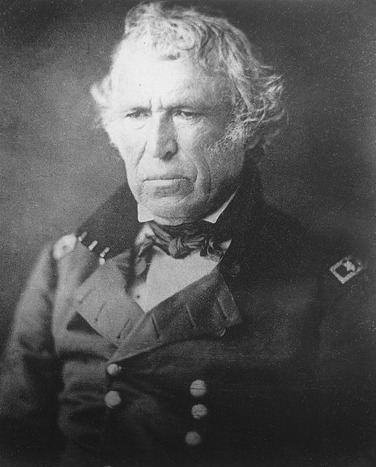They Taylor family left their land in Virginia and migrated westward to Kentucky. His family grew their roots in a small woodland cabin until their plantation prospered and afforded to move in a brick house. Richard Taylor acquired 10,000 acres of land in Kentucky. He even bought slaves to tend on their properties.
Zachary Taylor received a modest education since the education system was still developing in Kentucky during his formative years. His mother homeschooled him because they found it hard to find a tutor in the frontier. She taught him how to read and write then later attend a school run by Elisha Ayer. She described Zachary Taylor as a fast learner; however, he had poor handwriting.
He married Margaret Mackall Smith, a wealthy Maryland family member in 1810, and had five daughters and a son. They lost two of their daughters due to sickness.
When he was 22, he enlisted in the army and received his first commissioned as an officer after two years. Zachary Taylor served as the commander of Fort Pickering, Tennessee.
His first combat experience was during the War of 1812. Zachary Taylor successfully holds off an attack from Tecumseh, chief of Shawnee. Zachary Taylor then became a commander of Fort Jesup in the Louisiana Territory border and Texas in the 1820s.
After decades of military service, the then hone his military experience as he led the troops against a coalition of Sauk, Meskwaki, and Kickapoo Indians in the Black Hawk War in 1832. Zachary Taylor then became the commander of the U.S. forces in Florida in the Second Seminole War in 1837 until 1842.
In 1845, he stationed back to Fort Jesup; however, he received orders to defend the newly acquired Texas republic during James Polk’s administration. They were the frontline of the United States against Mexico. In March 1846, his 4,000 troops marched south to the Rio Grande. As Mexican troops attacked and killed eleven U.S. forces, President James K. Polk declared war against Mexico because of the said attack. Despite being outnumbered, Zachary Taylor defeated the Mexican forces at Palo Alto. The next day, his troops engaged another battle with the Mexicans in Resaca de la Palma. They were able to drive them back to Matamoros. He earned the nickname, “Old, Rough and Ready” for his willingness to fight side by side with his men.
Zachary Taylor established a base at Camargo at the Rio Grande as he awaits for the reinforcements. As the number of his troops grew, they charged south to beleaguer Monterey, Mexico. It was the Mexican’s largest northern city and garrisoned by thousands of army commanded by General Pedro Ampudia. After three days of battle, Zachary Taylor’s troops took the city. As the commander, he granted an eight-week armistice with Ampudia’s forces; however, President Polk ordered him to terminate the truce. This ruthless order from Washington left Zachary disappointed with the administration. Because of it, the Whigs eyed him to become the possible presidential candidate in the 1848 presidential elections.
Despite his inactive participation in politics, he accepted the Whigs’ nomination in their aligned principles for a protective tariff, internal improvements, and other policies. Hailed as a war hero of that time, he easily won against the Democratic candidate, Lewis Cass.
In the office, he declined to become the puppet of the Whig leaders in Congress. There are times that he acted as if he was above his party. Zachary Taylor attempted to manage the administration similar to his rule of thumb fashion in the military.
In 1848, the California Gold Rush kicked off and caused a tremendous pressure in resolving the territory’s statehood. Many citizens migrated to the new state, causing expansion in its population.
Zachary Taylor’s tenure in the office was shrouded with slavery controversy as it erupts with the intensity over establishing new institutions in the newly acquired territories. He was a slave owner himself and reluctantly admitted to California and New Mexico as Free states.
In his effort to put an end on the dispute over slavery, he wished the settlers in California and New Mexico to draft a constitution and to be admitted in the Union to expedite, even skip the territorial phase. Slave advocates outraged because of his decision. Many of them believed that Zachary Taylor bypasses the legislative power.
Some southern leaders threatened the president with secession in 1850. It angered him and countered their threat that he will personally lead the army to enforce federal law to preserve the Union. Zachary Taylor gradually loses his willingness to appease southern slave advocates and much opposed Henry Clay’s compromise bill proposal.
His administration was blemished by financial scandals, which involves several members of his administration, including his Secretary of War, George Crawford.
Zachary Taylor was the second president who died in the office, after William Henry Harrison. On July 4, 1850, he attended a ceremony at the unfinished Washington Monument. On July 9, 1850, he died due to acute gastroenteritis. There is speculation that he was poisoned; however, the thoughts were disapproved after his remains were exhumed in 1991.
US Presidents | ||

